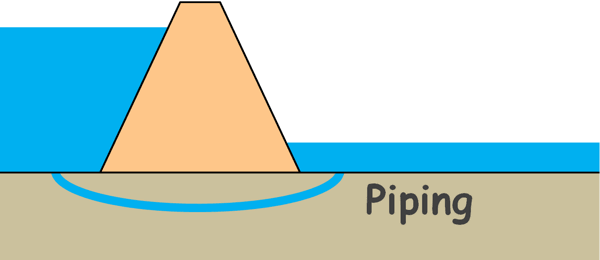Introduction
Piping is a phenomenon in geotechnical engineering where subsurface erosion occurs, leading to the formation of channels or pipes within soil. This can result in significant structural failures, especially in embankments, dams, and levees. Understanding the causes, effects, and mitigation strategies for piping is crucial for ensuring the stability and safety of geotechnical structures.

Causes of Piping
Piping typically occurs due to the following factors:
- Hydraulic Gradient: When water flows through soil, a hydraulic gradient is established. If the gradient is high enough, it can cause soil particles to be lifted and transported, initiating the piping process.
- Soil Permeability: Soils with high permeability, such as sands and gravels, are more prone to piping as they allow water to flow through easily. Cohesive soils like clays are less susceptible due to their lower permeability.
- Water Pressure: High water pressure, often due to heavy rainfall, rapid snowmelt, or poor drainage, can exacerbate piping by increasing the hydraulic gradient.
- Construction Practices: Poor construction practices, such as inadequate compaction or the presence of defects and discontinuities in the soil, can create weak points where piping can initiate.
Mechanism of Piping
The piping process generally follows these stages:
- Initiation: Water begins to flow through the soil, creating small channels as it transports finer particles.
- Progression: The channels enlarge as more soil particles are eroded and carried away by the flowing water, forming continuous pathways.
- Formation of Pipes: Eventually, these channels develop into larger pipes or tunnels within the soil.
- Structural Failure: If unchecked, the pipes can compromise the integrity of the soil structure, leading to localized collapses, sinkholes, or even the failure of larger structures like dams and levees.
Effects of Piping
- Structural Instability: Piping undermines the stability of soil structures, causing settlement, subsidence, and potential collapse.
- Flooding: In dams and levees, piping can lead to uncontrolled water seepage and potential breaches, resulting in flooding.
- Erosion and Sedimentation: Eroded soil particles can be deposited downstream, causing sedimentation in water bodies and impacting aquatic ecosystems.
- Economic Impact: Repairing and mitigating the effects of piping can be costly, affecting infrastructure, agriculture, and communities.
Detection of Piping
Early detection of piping is essential to prevent catastrophic failures. Methods include:
1. Visual Inspection:
Regular inspections of embankments and levees can help identify signs of piping, such as wet spots, sinkholes, or depressions.
2. Seepage Monitoring:
Monitoring seepage rates and water levels can indicate potential piping issues. Sudden increases in seepage may signal the onset of piping.
3. Geophysical Methods:
Techniques like ground-penetrating radar (GPR) and electrical resistivity tomography (ERT) can detect subsurface anomalies indicative of piping.
3. Piezometers:
Installing piezometers to measure pore water pressure can help identify abnormal hydraulic gradients that may lead to piping.
Mitigation of Piping
Effective mitigation strategies for piping include:
1. Proper Design:
Design structures to withstand expected hydraulic gradients and water pressures. Incorporate adequate drainage systems to manage seepage.
2. Soil Improvement:
Improve soil properties through compaction, grouting, or the use of geosynthetics to increase resistance to erosion and seepage.
3. Filters and Drains:
Install filters and drainage layers to intercept and safely convey seepage water, preventing the transport of soil particles.
4. Monitoring and Maintenance:
Implement regular monitoring and maintenance programs to detect and address early signs of piping.
5. Vegetative Cover:
Establishing vegetation on embankments and slopes can help stabilize the soil and reduce erosion.
6. Cutoff Walls:
Constructing impermeable cutoff walls, such as slurry walls or sheet piles, can block seepage paths and reduce the risk of piping.
Case Studies
- Teton Dam Failure (1976):The Teton Dam in Idaho, USA, failed catastrophically due to internal erosion and piping, leading to significant flooding and loss of life. The failure highlighted the importance of understanding and mitigating piping risks in dam design.
- Kosi Embankment Breach (2008):In India, the Kosi River embankment breached due to piping, causing widespread flooding and displacement. The event underscored the need for regular inspection and maintenance of flood control structures.
Conclusion
Piping is a critical concern in geotechnical engineering, posing risks to the stability and safety of soil structures. Understanding its causes, mechanisms, and effects is essential for designing and maintaining resilient infrastructure. Through careful design, monitoring, and mitigation strategies, the risks associated with piping can be effectively managed, ensuring the longevity and safety of geotechnical projects.